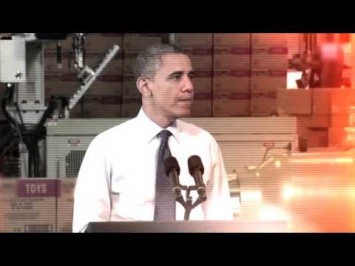

Fresh off an electoral battering, Crossroads GPS is picking up the pieces and regrouping with a fresh “issue” ad tarring the president’s opening bid on a deal to avert the upcoming tax increases and spending cuts known collectively as the “fiscal cliff.” The group’s accusations about a “huge tax increase” without accompanying spending reforms fall short, however. President Obama’s initial offering included both revenue increases – $1.6 trillion, to come primarily from an expiration of top-bracket tax rate cuts and limiting deductions – and $600 billion in spending cuts, most of which would come from health care programs.
Obama’s Proposal Includes Both Spending Cuts And Needed Revenues
Obama’s Proposal Includes Both Spending Cuts And New Revenue. From Bloomberg: “What does Obama want? The president wants $1.6 trillion in tax increases over the next decade. He has proposed $600 billion in spending cuts, about $350 billion of which would come from health-care programs. He also counts the $1 trillion in spending cuts Congress passed in 2011, $800 billion in savings from winding down the wars in Iraq and Afghanistan and $600 billion in interest savings, according to senior administration officials. Leaving aside the administration’s call for measures to boost short-term economic growth, which could take the form of tax cuts or spending increases, this would result in $2.4 trillion in spending cuts and $1.6 trillion in higher taxes.” [Bloomberg, 12/3/12]
Proposed $1.6 Trillion In Tax Increases Fall Mostly On Top Earners. From Bloomberg: “The administration’s plans call for a two-stage tax increase that would raise taxes by $1.6 trillion over 10 years. Right now, they want to let the 2001 and 2003 tax cuts expire for top earners. That would push the top tax rate on capital gains to 23.8 percent, the top rate on ordinary income to 39.6 percent and the top rate on dividends to 43.4 percent. The plan would reinstate limits on personal exemptions and deductions. What comes in stage two? By Aug. 1, the administration wants Congress to pass a plan that would enact the rest of the administration’s tax agenda — about $600 billion in higher taxes. What the administration has proposed in its budget beyond the immediate rate increases is about $1 trillion in tax increases and about $360 billion in tax cuts. That’s a net tax increase of more than $600 billion. Some of the increases would make it more difficult for U.S.-based companies to defer taxes on income earned overseas. The cuts include a permanent extension of a tuition tax credit and the credit for corporate research. The biggest increase would reduce the value of top earners’ tax breaks by requiring them to take such breaks as if they paid taxes in the 28 percent bracket.” [Bloomberg, 12/3/12]
There Is An Unusually Large Gap Between Federal Revenues And Outlays. From FactCheck.org: “There is a growing consensus in Washington that there needs to be a combination of increased revenues and spending cuts to close the big gap that has developed in recent years between revenues and outlays. As a percentage of the nation’s economy, the gap between what Washington spends (22.7 percent) and collects in revenues (15.7 percent) narrowed slightly in the last fiscal year. But the federal government is still a long way from the times when revenues more closely matched spending — as you can see from the chart below. We created the chart using historical budget data from the federal Office of Management and Budget, updated with Treasury Department figures for the fiscal year ending Sept. 30, 2012.” FactCheck.org also included the following chart:
[FactCheck.org, 11/30/12]
GOP Counter-Offer Cuts More From Spending Without Raising Rates. From CBS News: “Mr. Obama’s latest, publicly disclosed, ‘fiscal cliff’ proposal calls for $1.6 trillion in new revenues, achieved in part from letting the Bush-era tax cuts expire for the wealthiest Americans, as well as $600 billion in spending cuts. Republicans put forward a counter offer that is made up of $900 billion in spending cuts and $800 billion in new revenues achieved through tax reform—not tax increases.” [CBS News via KHOU.com, 12/5/12]
CBO: Raising Taxes Would Have Minimal Negative Economic Impact, But Spending Cuts Will Disproportionately Harm Growth. From the Washington Post: “A new study (pdf) by the International Monetary Fund raises a further warning flag for fiscal cliff negotiators in the U.S. In what it bills as the first-ever study of its kind, the fund analyzed decades of data on the world’s major industrialized countries to estimate how changes in government spending or revenue affect economic output. The news isn’t good. Given current circumstances, with a U.S. economy that is growing but still trying to make up lost ground from the 2008 crisis, a one dollar change in government spending could knock as much as $1.80 in output from the economy – what fund researchers called a ‘statistically significant…and sizeable’ outcome. One brighter spot that could also influence negotiators: the growth impact of a tax hike is estimated to be negligible. The list of measures that automatically become law absent an agreement include both spending reductions and tax increases. While the spending cuts would comprise a heavy drag on growth, the fund paper suggests that a one percent rise in tax revenue would knock just 0.1 percent from gross domestic product.” [Washington Post, 11/8/12]
[PRESIDENT OBAMA CLIP:] “If we’re serious about reducing the deficit, we have to combine spending cuts with revenue.” [NARRATOR:] But so far, a huge tax increase is his solution. No real spending reforms. Instead, more taxes. The time for politics has ended. We need bipartisan ideas we can all support. Call President Obama and tell him: It’s time to show us a balanced plan, because every day wasted is another $4 billion we’re deeper in debt. [Crossroads GPS via YouTube.com, 12/5/12]



